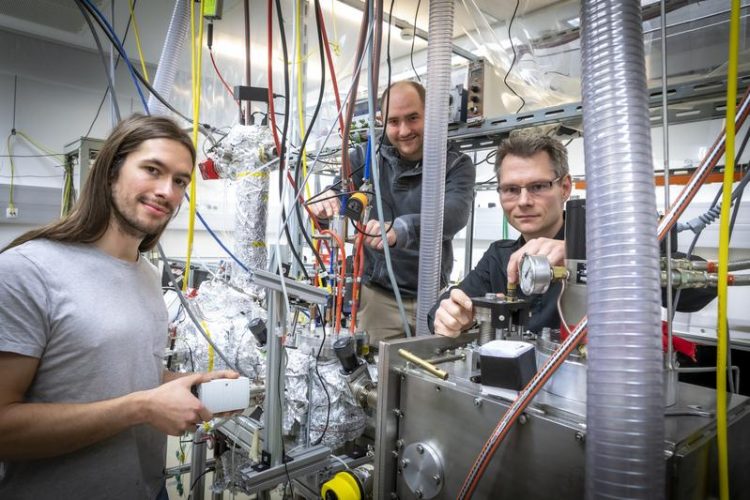New simulation-experiment combination allows deeper insights into ultrafast light-induced processes

Their experiments were part of the success of the research: Pascal Heim, Stefan Cesnik and Markus Koch from TU Graz (f. l.) © Lunghammer - TU Graz
Since the 1990s, femtochemistry has been researching ultrafast processes at the molecular level. In the last few years, the research group Femtosecond Dynamics at TU Graz’s Institute of Experimental Physics has been able to achieve a number of successes in the area of light-matter interaction.
“A precise understanding of the processes triggered by photoexcitation in molecules is, for example, a prerequisite for the development of sustainable technologies that enable an energy supply based on solar energy,” says Markus Koch, the head of the working group.
As an example, he cites photocatalysis, which helps to convert sunlight into chemical energy with advantages in terms of long-term storage and energy density when compared to the generation of electrical energy via photovoltaics.
One method for such molecular dynamic investigations makes use of so-called pump-probe measurements applying an ultrashort laser pulse to excite (“pump”) a molecular system into a desired state. After an adjustable delay time, a second (“probe”) laser interrogates the population of the excited state by ionizing the molecule.
The energy of the emitted photoelectrons is measured and by varying the pump-probe delay time, conclusions can be drawn about the energy flow in the molecule.
Heisenberg's energy-time uncertainty principle prevents exact results
An exact description of light-induced processes on their real time scale has so far failed for some polyatomic molecules that may take different decay or fragmentation routes after excitation, depending on the choice between closely spaced energy states.
As a result of Heisenberg’s energy-time uncertainty principle, laser pulses of only femtosecond (10-15 seconds) time duration cannot selectively excite closely neighbouring molecular states. However, short pulses are a prerequisite for the observation of extremely fast processes.
New approach combines theory and experiment
In collaboration with researchers of the Institute of Theoretical Chemistry at the Faculty of Chemistry of the University of Vienna under the direction of Prof. Leticia González, the experimental physicists in Graz have now overcome this hurdle.
By combining experiments with ultrashort laser pulses and theoretical simulations of light-induced processes, the energy flow in acetone – a molecule that has already been well studied – could now be observed for the first time at a key energy window between three closely related states.
Even for the Vienna group, a driving force in the field of the theoretical description of molecules after light excitation, the system under investigation presented a challenge. “For these simulations, new developments in our local software package SHARC were necessary, without which the correct description of acetone dynamics would not have been possible,” emphasizes González.
Synergy effects yield new insights
Both methods in themselves are widely used, but “while the energy-time-blur relation in femtosecond spectroscopy prevents precise results, real-time simulations provide deeper insights into molecular dynamics, which in turn require the experimental results to be verified,” explains Koch.
The combination of these two techniques now provides researchers with a deeper insight into acetone dynamics and is a further milestone in the study of light-matter interactions. The results were published in The Journal of Physical Chemistry Letters.
This research area is anchored in the Field of Expertise “Advanced Materials Science”, one of five strategic foci of TU Graz. Participating researchers are members of NAWI Graz Physics.
DI Dr. Markus Koch,
Assoc.Prof. Dipl.-Ing. Dr.techn.
TU Graz | Institute of Experimental Physics
Rechbauerstrasse 16, 8010 Graz
Phone: +43 316 873 8161
markus.koch@tugraz.at
Leticia González
Univ.-Prof. Dr. Dr. h.c.
University of Vienna | Institute of Theoretical Chemistry
Währinger Str. 17, A-1090 Vienna
Tel: +43-1-4277-52750
leticia.gonzalez@univie.ac.at
Revealing Ultrafast Population Transfer between Nearly Degenerate Electronic States
Pascal Heim, Sebastian Mai, Bernhard Thaler, Stefan Cesnik, Davide Avagliano, Dimitra Bella-Velidou, Wolfgang E. Ernst, Leticia González, and Markus Koch
The Journal of Physical Chemistry Letters 2020, 11, 1443−1449
DOI: 10.1021/acs.jpclett.9b03462
https://www.tugraz.at/institute/iep/forschung/femtosecond-dynamics/ (research group Femtosecond Dynamics at TU Graz’s Institute of Experimental Physics)
https://theochem.univie.ac.at/ (University of Vienna | Institute of Theoretical Chemistry)
https://www.nawigraz.at/en/ (NAWI Graz)
https://www.tugraz.at/en/research/fields-of-expertise/advanced-materials-science… (FoE “Advanced Materials Science)
Media Contact
All latest news from the category: Materials Sciences
Materials management deals with the research, development, manufacturing and processing of raw and industrial materials. Key aspects here are biological and medical issues, which play an increasingly important role in this field.
innovations-report offers in-depth articles related to the development and application of materials and the structure and properties of new materials.
Newest articles

Properties of new materials for microchips
… can now be measured well. Reseachers of Delft University of Technology demonstrated measuring performance properties of ultrathin silicon membranes. Making ever smaller and more powerful chips requires new ultrathin…

Floating solar’s potential
… to support sustainable development by addressing climate, water, and energy goals holistically. A new study published this week in Nature Energy raises the potential for floating solar photovoltaics (FPV)…

Skyrmions move at record speeds
… a step towards the computing of the future. An international research team led by scientists from the CNRS1 has discovered that the magnetic nanobubbles2 known as skyrmions can be…





















